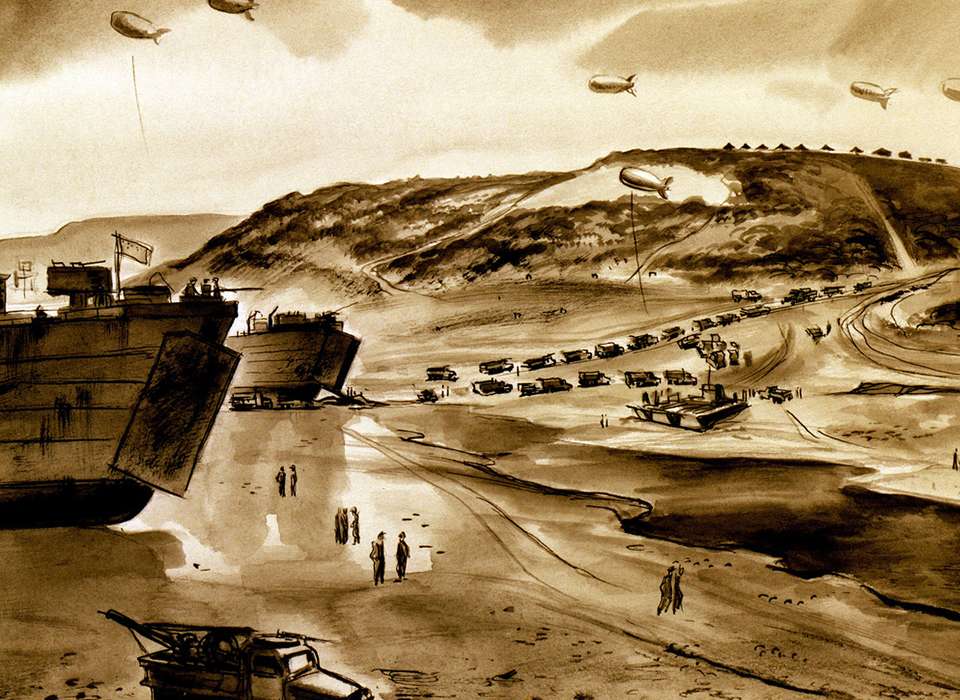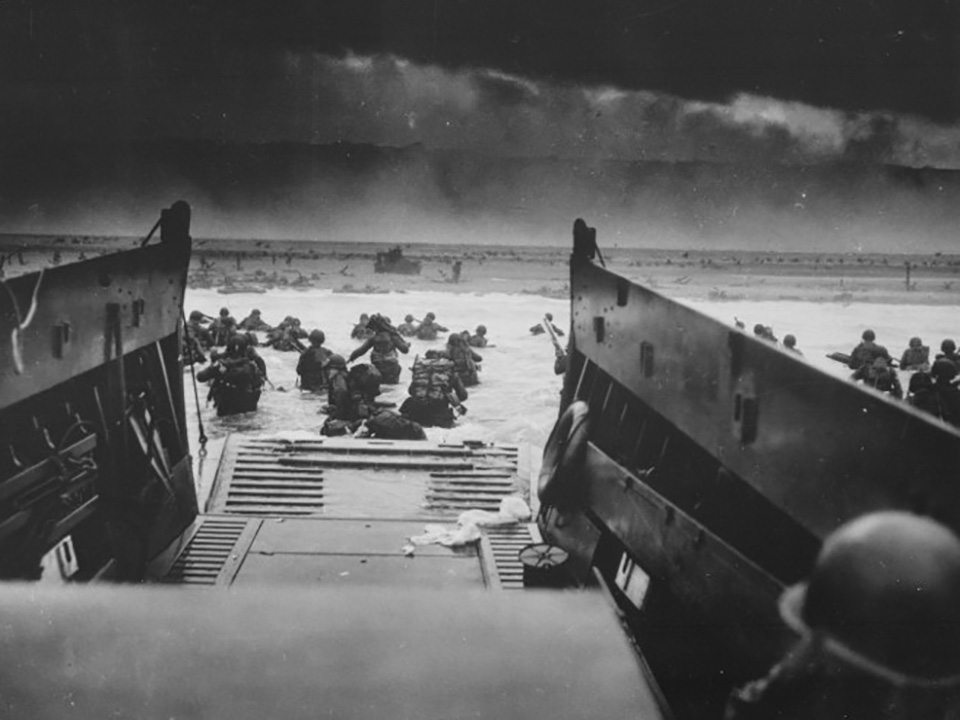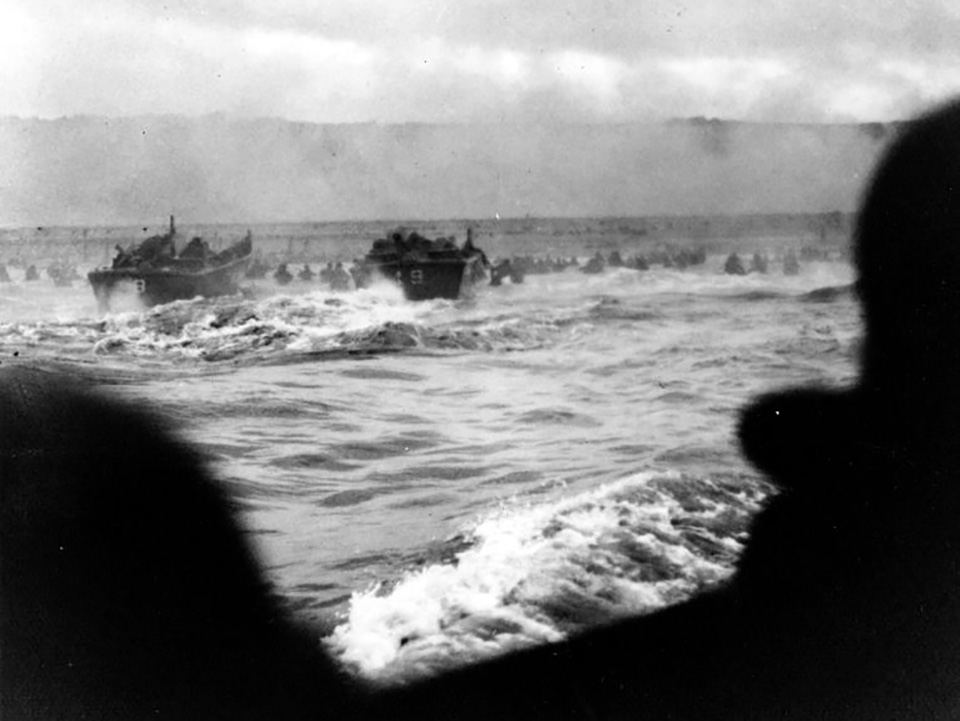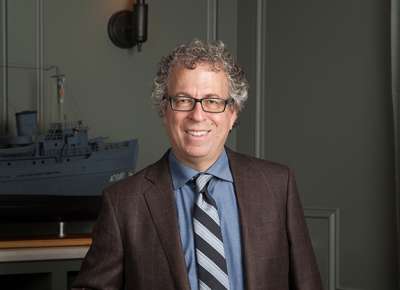Top Image: Combat artist Harrison Standley's "Exit from Omaha Beach" painted after the beach and bluffs had been secured. Courtesy of the National Archives.
It’s the anniversary of D-Day, a special day for The National WWII Museum. Indeed, we began our existence as a “D-Day Museum,” dedicated to preserving the memory of those stirring events of 1944, and we never fail to call them to mind when June 6 rolls around.
This year isn’t one of the “major” anniversaries—the 50th or 75th or 100th, for example. It’s 2020, the 76th. And yet, the present moment seems like an appropriate time to recall what happened in Normandy on that long-ago June morning.
Then, as now, there was a difficult job to be done. In Normandy, the task involved an enemy-held beach, well-sited machine gun nests, concrete bunkers, and forbidding bluffs. If you ever get a chance to travel to Normandy, be sure to visit the stretch of coastline between Vierville- and Colleville-sur-Mer, the beach codenamed “Omaha.” You’ll see the sea in front of you, cliffs behind you, and between them, a series of hulking German fortifications, or Widerstandnesten (“resistance nests.”) As you stand there and survey the ground, you’ll probably have the same reaction that I do and that thousands of visitors have every year. You’ll ask yourself, “How did our heroes even get ashore?”
Today, we’re on a beach of our own, not “Omaha” or “Utah,” but COVID-19. We have obstacles in front us, too, not the German army and its gigantic concrete fortifications, but a devious, microscopic foe, an infection curve that needs flattening, “stay at home orders” and social distances that our doctors tell us need to be maintained in order to slow the enemy’s pace. As I write this, the country is in the grip of an economic shutdown that has now stretched into months. Rather than the “big bang” of the Omaha landing, this operation is slow, grinding, and immensely frustrating.
And yet, many of the same virtues that the US Army demonstrated on Omaha are exactly what the nation needs today. Courage to face the unknown. A willingness to put your own needs on hold and put those of others first. Teamwork. These are all soldierly virtues—pounded into the recruit from the moment s/he joins the service, but they are not a bad guide to civilian life, either.
That last one—teamwork—can sometimes appear to be difficult for Americans. We like our personal freedoms, our sense of “rugged individuality.” We come and go as we please. Here in New Orleans, we feel we have a constitutional right to eat at any restaurant we choose, and the notion of all of them closing at once really did seem like a state of emergency.
But here’s something else about Americans that I’ve learned in my 61 years of living among them. They pull together. They help each other. They’ll give you the shirt off their back if you need it. Floods, fires, earthquakes, you name it: Americans do what needs to be done. And I’ve been seeing it in the current crisis as well. And as we survey the current scene, the numbers are trending downwards, the curve has flattened, and it looks like we might have seen the worst of COVID-19. It’s too early to declare victory, of course, but positive signs are in the air.
American soldiers wade ahore at Omaha Beach on June 6, 1944 with the German held bluff in the background. Courtesy of the National Archives.
Make no mistake: this has been a tough slog, and it’s been easy to get depressed. But there’s one other soldierly virtue worthy of mentioning: perseverance when things seem to be going wrong, and especially when they seem to be going badly wrong. Soon after hitting the beach, US troops on Omaha were looking at a full-fledged disaster. Even so, they didn’t sit there wringing their hands, and they didn’t panic or run around blindly. They also didn’t surrender.
And neither will we.
Today, take some time out of your normal routine—whatever “normal” looks like for you nowadays—and think about some very young Americans who faced down their own deadly crisis, 76 years ago.

My Father's D-Day: Family Legacies from the Normandy Invasion
Career newspaper photographer Eliot Kamenitz reflects on his father’s role as a glider pilot on D-Day and in two other military actions in Europe, and the pivotal importance of the D-Day experience in his father’s life.
Robert Citino, PhD
Robert Citino, PhD, is the former Samuel Zemurray Stone Senior Historian in the Jenny Craig Institute for the Study of War and Democracy.
Cite this article:
MLA Citation:
APA Citation:
Chicago Style Citation:







![Max Fuchs, New York City cantor, sings as Rabbi Sydney [sic] Lefkowitz, Richmond, VA, conducts the first Jewish services from Germany.](/sites/default/files/styles/max_650x650/public/2025-10/image1.jpg)



